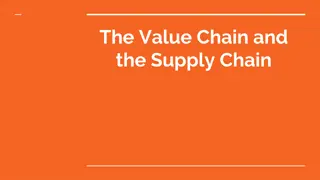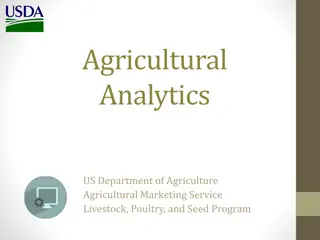Unlocking Agricultural Sector Potential Through Value Chain Analysis
Agricultural entrepreneurship is vital for economic growth in Kenya. This academic exchange visit to the University of Nairobi highlights the importance of agripreneurship and commodity value chain analysis in maximizing the sector's potential. The key focus is on identifying, mapping, and addressing bottlenecks and constraints within commodity value chains to enhance market interventions and opportunities.
Download Presentation

Please find below an Image/Link to download the presentation.
The content on the website is provided AS IS for your information and personal use only. It may not be sold, licensed, or shared on other websites without obtaining consent from the author. Download presentation by click this link. If you encounter any issues during the download, it is possible that the publisher has removed the file from their server.
E N D
Presentation Transcript
INSEFOODS ACADEMIC EXCHANGE VISIT DEPARMENT OF AGRICULTURAL ECONOMICS UNIVERSITY OF NAIROBI By Prof. Obel-Gor, Christopher (PhD-AgEcon) DECEMBER, 2021 1
GUEST LECTURE TO FACULTY OF AGRICULTURE YEAR 1 STUDENTS TOPIC: Agripreneurship Background: In many Developing countries including Kenya, the Agricultural sector is still the most dominant contributor to the economic growth in the country. According to RoK (2012) agriculture is the mainstay of Kenya s economy, currently contributing 24 per cent of the GDP directly, and another 27 per cent indirectly. 2
Contribution cont.. Agripreneurship The sector also accounts for 65 per cent of Kenya s total exports; provides more than 18 per cent of formal employment; accounts for more than 70 per cent of informal employment in the rural areas, and generally provides a livelihood for close to 80 per cent of the Kenyan population. Simply put, Agripreneurship refers to the act of turning an idea into a business venture in the agricultural sector 3
Agripreneur By definition, an Agripreneur is an individual who: starts, organizes and manages a business venture focusing on the agricultural sector. Broadly, Agri-entrepreneurship or Agripreneurship provides value addition to agricultural resources typically engaging rural human resources (Boidurjo R.M, 2020) (https://www.researchgate.net/publication) 4
UNLOCKING THE SECTOR POTENTIAL (Through Commodity Value Chain Analysis) The four identified Segments of a Commodity Value Chain include: INPUT SUPPLY Segment PRODUCTION Segment MARKET Segment CONSUMPTION Segment 5
OBJECTIVE OF THE VCA The objectives of the VCA: Identification/selection of the target commodity value chains, Mapping the commodity Value Chains, Identifying Bottlenecks and Constraints in the Value Chains and developing the desired market interventions and opportunities to address the constraints. 6
Record Record- -keeping or record analysis? keeping or record analysis? Record-keeping refers to keeping, filing, categorizing and maintaining farm financial and production information. Record-keeping can be accomplished through a variety of methods, from a basic hand record-keeping method to an elaborate computerized system. Record analysis refers to evaluating farm records. The evaluation process allows a farm manager to make informed decisions based on actual (or projected) farm performance. 8
Record Keeping cont.. Obviously, record analysis cannot take place without first keeping records. Therefore, establishing and using an effective farm record- keeping system for an ongoing farm operation aids - in farm planning, -informed decision-making, and analysis of both production and financial records 9
Production or financial records? On the farm, there are two distinct types of records financial and production. +Financial records relate primarily to money or the financial interactions of the farm. +Financial records justify or prove farm income or expense transactions. 10
Financial records cont.. Product sales, operating expenses, equipment purchases, accounts payable, +accounts receivable, inventories, depreciation records, +loan balances and price information are all examples of financial records. 11
Production records Production records are items that relate to: + quantities of inputs and levels of production by enterprise and/or by resource type. +They consist of crop yields, plant populations, calves born, pounds of milk produced, +weaning weights, death loss, etc. Both production and financial records are important to the efficient management of today s farm business. 12
Selecting a recordkeeping system Selecting a record-keeping system should depend on the expected use of the records. + There is no best record keeping system for all situations, but, at minimum, a farm records system should: +provide accurate and necessary information - fit into the farm organization or framework : +- be available in a form to aid decisionmaking 13
Selecting a recordkeeping system cont.. A double-entry accounting system provides the most detailed accounting of farm business transactions. A significant amount of time is usually needed to learn and implement such a system. The simpler cash accounting system, with inventory adjustments, will suffice for most farm operations, and is an accepted method of reporting income and expenses for tax purposes 14
REFERENCES: Alex Wasonga Dianga , Ken Lohento and Eric Bosire (2020). Supporting and Scaling Up Youth Agripreneurship in Kenya. Boidurjo Rick Mukhopadhyay. (March, 2020). Agribusiness, Agri-entrepreneurship and Sustainable Intensification Republic of Kenya. (June, 2012). National Agricultural Sector Extension Policy (NASEP) 15























